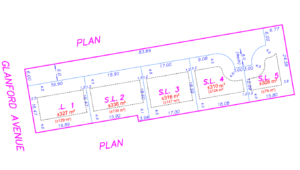Small-Scale, Multi-Unit Housing”
Hi Chris,
I hope you’re having a great week!
Over the past month or so, I have had a few friends ask my thoughts on the new Housing Legislation.
There are so many unknowns at the moment, and in some cases, it’s put new development applications on hold. In June, I’m hopeful we will know more about the application process and housing types that will be allowed.
The legislation will force municipalities to approve up to six units on a single-family lots in order to create more so-called “missing middle” housing such as townhouses and multi-unit homes.
Please see below an overview of my understanding.
The Province has created 3 new policies:
- Bill 35: Short-Term Rental Accommodation Act, 2023
- Bill 44: Housing Statutes (Residential Development) Amendment Act, 2023
- Bill 47: Housing Statutes (Transit-Orientated Areas) Amendment Act, 2023
Today, I will only touch on Bill 44 which is focused on Small-Scale, Multi-Unit Housing up to 6 units per lot.
In a future, I may discuss Bill 47 and how the density will impact areas around Transit-Orientated Developments.
Projected Implementation:

Introduction to Proposed Zoning Changes
The upcoming legislation and regulations are set to transform local government zoning bylaws. These changes mandate creation of small-scale, multi-unit housing developments within urban areas.
This will affect municipalities with a population of at least 5,000 residents and those within the urban containment boundaries.
Bill 44 Provisions:
- Mandates local governments to permit the construction of higher-density housing, specifically on properties currently zoned for single-family homes or duplexes.
- Eliminates the requirement for public hearings if the proposed development is consistent with the official community plan and zoning bylaws.
It’s important to understand that the legislation permits the construction of either 3 or 4 units “by right” meaning that these dwellings can be built without the need for Council approval.
This is similar to the current regulations for single- and two-family homes, where obtaining a building permit is sufficient to begin construction.

Key Provisions of the Proposed Legislation
3 to 4 Units on Single-Family and Duplex Lots
- Local governments will permit 3 to 4 housing units per lot. For lots that are single-family or duplex zoned.
- The number of units will be determined by the lot size.
- Lots under 280 square meters will allow for 3 units, and those over 280 square meters permitting 4 units.
6 Units on Larger Lots
- If close to transit with frequent service, 6 units will be allowed. For larger lots (exceeding 281 square meters).
- This changes the zoning landscape. Particularly, in areas currently designated for single-family or duplex housing.
- Provided they are situated within 400 metres of a bus stop. This bus stop must offer service at an average frequency of every 15 minutes during the hours of 7 am to 7 pm from Monday to Friday, and 10 am to 6 pm on Saturdays and Sundays.
Moving Away from Exclusive Single-Family Zoning
- This change signals a move away from neighborhoods only zoned for single-family homes.
- It aims to streamline the process. By allowing the construction of triplexes or converting single-family homes into multi-unit dwellings

Guidelines on Parking and Transit Proximity
Parking Regulations Based on Location and Lot Size
- The province will issue specific guidelines on parking requirements. This will vary depending on the lot size and distance to transit stops. Parking requirements will be reduced for Small-Scale, Multi-Unit (SSMU) projects near transit stops.
Special Provisions for Projects Near Transit Stops
- Addressing Parking Needs in Different Areas. There will be parking guidelines for areas further from transit. For SSMU projects close to transit stops parking minimums will decrease.
- No Minimum Parking for Projects within 400M of Transit Stops. Parking will be at the discretion of home builders. Allowing for more flexible and context-sensitive solutions.
Provincial Guidelines on Development Permits for SSMUH
Handling of Development Permits in SSMUH Projects
- Provincial guidelines suggest that Development Permits (DPs) should not be employed to hinder the development of Small-Scale Multi-Unit Housing (SSMUH).
- Nonetheless, DPs might still be necessary. The guidance advises that municipalities should “mirror the approval process applied to single-detached homes,” meaning they should either bypass DP processes for SSMUH projects or assign them to staff members for handling.

Understanding Small-Scale, Multi-Unit Housing (SSMUH)
Definition and Purpose of Small-Scale Multi-Unit Housing
- SSMUH is a term used for a variety of building types and unit configurations.
- The primary goal of SSMUH is to offer more affordable and attainable housing options.
- These units are designed to be smaller in scale and often providing modest yard spaces. Which are ideal for families with children and pet owners.
Examples of Small-Scale, Multi-Unit Housing
Diverse Forms of SSMUH
Secondary Suites
- Secondary suites are extra living spaces created within single-family homes or duplexes. These units often have their own separate entrances. And are functional as independent living spaces.
Detached Garden Suites and Laneway Homes
- Detached garden suites. Laneway homes. Refer to small, standalone residential units. Situated on the same lot as a primary house. They are in the backyard or next to an alley (laneway).
Triplexes
- Triplexes consist of three separate housing units within a single building structure. Each unit typically has its own entrance, living areas, and amenities.
Townhomes
- Townhomes are multi-unit residential buildings. Where each unit shares one or more walls with adjacent units.
House-Plexes
- House-plexes are larger residential structures that contain multiple, separate living units. They resemble traditional houses in appearance. But function like apartment buildings, with individual units for different residents or families.

Challenges & Opportunities:
These changes are anticipated to have a significant impact on the housing market and development in B.C.
They will also likely pose new challenges and opportunities for municipalities, developers, builders, and landowners, as they navigate the new legal landscape and market conditions.
Will this help with the affordability challenges? Likely not, but it will promote greater housing density and diversity.
Through these different housing forms, SSMUH aims to provide flexible and accessible housing options. Catering to a diverse range of living needs and preferences.
As mentioned, I wanted to give a little overview of my understandings. Any improvements to getting a project through approvals would be much appreciated… it shouldn’t take us 4 years to get a straight-forward subdivision approved!
Please feel free to reach out if you have any questions or thoughts!
Enjoy the week,
Matt

